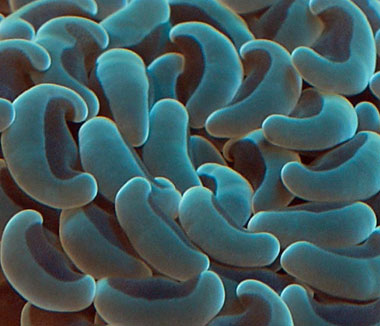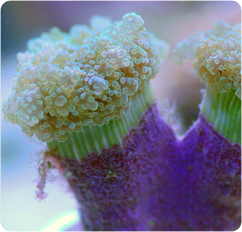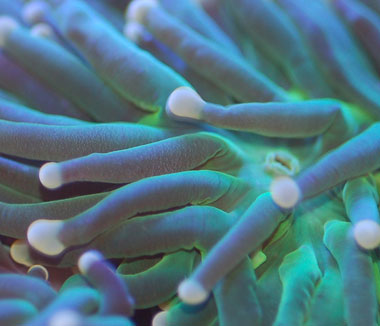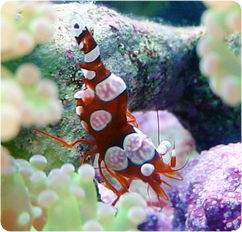|
Genus Euphyllia
Beautiful Corals for Novice and Advanced Aquarists Alike
 |
| Like most Euphyllia Species, hammer or anchor coral (Euphyllia ancora) derives its common name from its polyp shape. |
The family Caryophylliidae includes many of the most popular corals in the marine aquarium hobby, but it is the corals from the genus Euphyllia with which we are most interested in this article. Whether it’s frogspawn (E. divisa), torch coral (E. glabrescens) or hammer coral (E. Ancopra), species from this genera are well represented in many aquarists’ reef tanks. These are, generally-speaking, hardy corals that tend to acclimate well to the home aquarium. Since they are fairly hardy, corals from the genus Euphyllia can even be appropriate beginner corals. They are also, in many aquarists’ opinion, about as good-looking as almost any coral species and, as such, are loved by serious collectors.
Corals from the genus Euphyllia all possess thin skeletons, fully retractable polyps, long sweeper tentacles, and powerful stinging cells. Unlike many corals, species identification is generally easy and based on polyp shape. All Euphyllia species have polyps which are almost always fully extended during the day. Greens, browns and translucent pinks are most common colors, although the tips of the tentacle often have a contrasting color.
Potential Problems – Acquiring a Healthy Specimen
One of the biggest potential problems with Euphyllia species is ensuring that you acquire a healthy specimen in the first place. Many of these corals, despite their general hardiness, are easily damaged during collection and shipping, and it is essential that you carefully inspect a specimen before purchasing. [At Blue Zoo Aquatics, we take care of that part of the process for you, as our husbandry staff only sends undamaged, healthy Euphyllia specimens. If, however, you do find a problem, our guarantee will take care of it. –ed.].
 |
| There should be no damage to the top edge of the skeleton and any tissue regression. A Healthy branch frogspawn (Euphyllia paradivisa) is pictured here. |
When examining a specimen, look for the top edge of the skeleton to be intact, and make sure there are no signs of tissue regression. When handling this animal, never remove it from the water while its polyps are extended. Additionally, specimens should only be touched on their non-living skeletons. If you are purchasing the specimen at the local fish store, it will probably be bagged for you and attached to a piece of Styrofoam floating upside down in the water. This is usually sufficient, although Bob Fenner, author of The Conscientious Marine Aquarist, also suggests that this coral could be “gingerly wrapped in sheets of plastic bagging underwater and double, triple bagged with a liner for transport.” This is especially true when a long or potentially rough transport is anticipated.
Placing the Euphyllia Specimen
After acquiring a healthy Euphyllia specimen and getting it safely to your tank, you must take care in placing it appropriately. Euphyllia species are indeed hardy and adaptable, but only if they are placed properly to begin with. While you should always research the individual species, most Euphyllia species appreciate moderate lighting and intermittent moderate to strong flow.
Euphyllia species will not tolerate, as Mark Martin, director of marine ornamental research at Blue Zoo Aquatics, puts it, “laser beam flow.” For best results, provide plenty of flow, but do it using “intelligent powerheads” that produce diffuse, intermittent current. Euphyllia species do great with closed loop systems (CLS) with alternating flow (produced by a SCWD or an Oceans Motions wavemaker) and in aquaria that employ waveboxes. The most important thing to keep in mind is that “laser beam flow” will lead to tissue damage and recession and potentially death of the entire colony secondary to bacterial infection. A good indicator that the specimen is properly placed is full polyp extension.
In terms of lighting, it is not uncommon for the new aquarist to photoshock his or her recently acquired Euphyllia specimen. Be sure to initially place it low in your aquarium or employ some sort of shading device to give it time to acclimate to your tank’s lighting. Once acclimated, you may affix the specimen to a moderately lit spot on your live rock using a two part epoxy or other aquarium-safe underwater bonding product.
 |
| Metallic green torch coral (Euphyllia glabresens ) with contrasting pink tips. |
Aggression
Finally, in terms of properly placing your Euphyllia specimen, keep in mind that these are aggressive corals with long sweeper tentacles (even longer if they experience too much flow). Leaving a half foot around this coral in all directions is a very good idea. Anecdotally, Euphyllia species may not do well in a tank dominated by soft or leather corals. Soft and leather corals are known to “sense” a threat when Euphyllia species are added to an established system, and, depending on the genus and species of soft or leather coral, chemical warfare may well ensue even if the specimens are not touching.
Husbandry Concerns – Diet and Disease
If you follow the above suggestions, you can expect a long-lived, beautiful coral specimen that will rapidly grow and can be easily fragged. In terms of ongoing husbandry, once or twice a week, it is best to target feed most Euphyllia species with small pieces of meaty seafood (e.g., raw table shrimp, scallop, etc.). Keep an eye out for any signs of tissue recession and bacterial infection (commonly called brown jelly disease). In areas of tissue recession, also watch out for filamentous algae growth.
A Closing Thought to Enhance the Display
 |
| Sexy shrimp ( Thor amboinensis ) hosting on a Euphylliaspecies. |
Once you have a Euphyllia specimen acclimated to your aquarium, do consider enhancing the display by replicating one or more of the fascinating symbiotic relationships between Euphyllia species and other animals in nature. For example, many of the anemone shrimp will readily host in Euphyllia species. Whether you choose to have your Euphyllia host a small invertebrate or not, keeping Euphyllia species in a reef tank is relatively easy and highly rewarding.
Published 22 July 2008. © Blue Zoo Aquatics
|